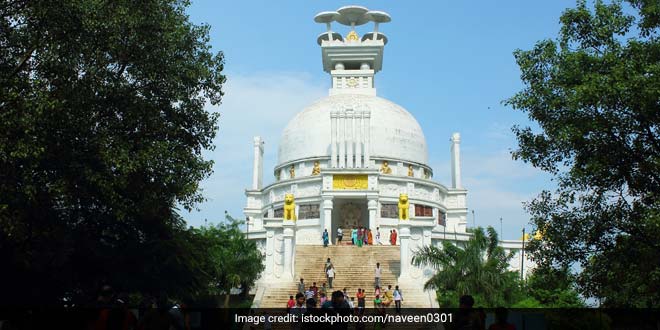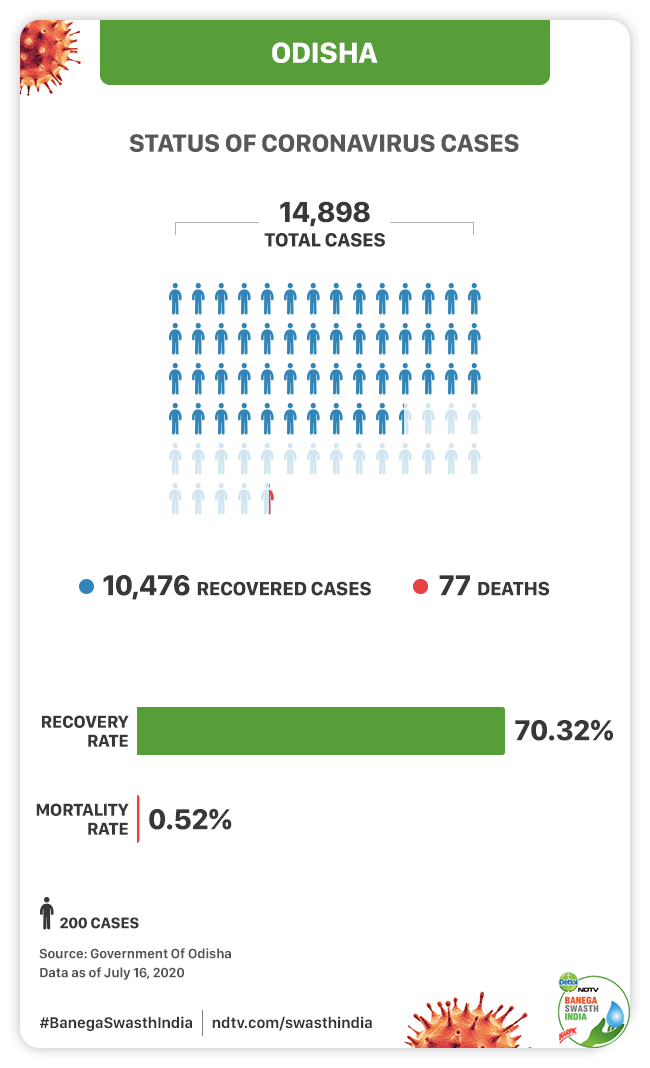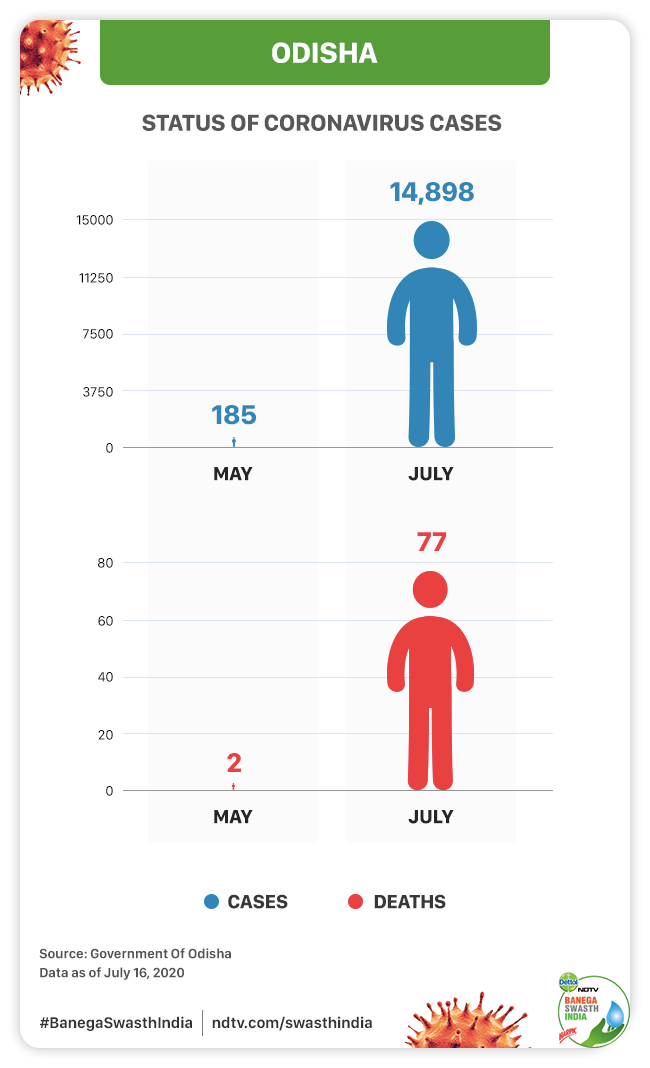New Delhi: Odisha claims many COVID-19 related firsts to its credit. From being India’s first state to kick-start coronavirus specialised hospitals to being the first state with dedicated COVID-19 facilities in all its 30 districts. But then the state started to see a sudden surge in coronavirus cases from 185 cases with 2 deaths in the month of May to 14,898 cases, with 77 deaths and more than 4,000 active cases as of July 16, according to the Ministry of Health and Family Affairs.
Earlier, the state had also got a thumbs up from World Health Organisation and UNESCO, as the teams found that the hospitals in the state have been operating with 96 per cent compliance in all parameters. But, the months of June and July changed the course of the state and its battle against coronavirus.
Also Read: 6 MONTHS ON, A RECAP OF HOW THE CORONAVIRUS PANDEMIC UNFOLDED
Apart from reporting a sudden surge in coronavirus cases, what is worrisome is the fact that a lot of new cases are being reported from hospitals across the state where hundreds of patients and healthcare workers are getting infected.
In the first week of July, according to the data provided by Odisha Government, the state had reported 77 fresh coronavirus positive cases, including 18 cancer patients who were undergoing chemotherapy at Acharya Harihar Regional Cancer Centre (AHRCC) in Cuttack, the state’s only government-owned cancer care hospital. It soon became one of the super spreaders of coronavirus cases as it reported 100-odd cases within few more days and got shut amid the COVID pandemic which disrupted the cancer care for patients in Odisha. Apart from AHRCC, Outpatient Department (OPD) of AIIMS, Bhubaneswar, which is the second government health institution with an advanced cancer care facility in Odisha HAD to be shut down recently after more than 96 of its patients and staff got infected with coronavirus over the week.
Also Read: 6 MONTHS ON, WHAT DO WE KNOW ABOUT THE CORONAVIRUS PANDEMIC
A Sudden Spike Of COVID-19 Cases: What Experts Think
Highlighting this sudden surge of coronavirus cases in Odisha, Director of AHRCC, Lalatendu Sarangi said,
Coronavirus – is a relatively new virus with no vaccination till date, moreover, people might even not know when they have contracted the virus. Even after taking all precautions, our hospital came out to be a hotspot of coronavirus cases, as cancer patients have very low immunity and doctors, with 100 per cent chance of contracting the virus. The disease is such that IT makes hospitals more prone to the virus, what we have learned from our case is that this can happen in any hospital, we just need to be very careful. For now, we have cleaned the old building and had done the sanitization and we plan to start Radiotherapy from this week.
Talking about Odisha’s status in dealing with the pandemic and what she thinks is the cause of the surge in coronavirus cases, Dr. Pujitha S.Padmanabhan, Indian Institute of Public Health – Bhubaneswar and Public Health Foundation of India said,
Odisha is seeing a sudden spike because the state has many super spreaders floating here and there. Then, full-scale marriages and functions are also ruining Odisha’s war on COVID-19. I think, authorities really need to work on a plan to educate and make people aware of coronavirus consequences, one of the most important learnings from Kerala. The state’s health care minister to government, all continuously made people aware of the pandemic, which I think is missing in Odisha as we are seeing a lot of such instances taking place. Secondly, there should be more stringent rules and fines in place for violators.
Sharing an example of Odisha’s coronavirus outbreak in recent past, she said that recently, a family of three, which is now being termed a COVID-19 “super spreader” in Odisha’s Rayagada district has said to be the source of infection to 87 people in a village. The family — a man, his wife and their daughter – had returned to their village, called Bijaypur, from Andhra Pradesh. According to the officials, the family were put under home-quarantine, but the family members allegedly did not adhere to prescribed norms and came in contact with several people in the village.
She further talked about the worst-hit district Ganjam and added,
The district has more than 4,000 COVID-19 infected people, yet, recently it saw a gathering of over 3,000 people at a temple inauguration in Ganjam district’s Pari Nuagaon village, violating despite the pandemic and the rules that were passed by the authorities regarding the closure of religious places. So, somewhere we are lacking in the strict policies and rules, when it comes to coronavirus.
Talking further about the need to protect healthcare workers in Odisha, Dr Padmanabhan added,
Thirdly, Odisha needs to protect its frontline workers, something which we have learned from Italy coronavirus outbreak. And when you will start losing many of your healthcare professionals then suddenly hospitals become overworked, which in this case they already are and then the chances of saving patients become less. According to the official data, more than 300 frontline workers including policemen, nurses, ASHA workers, doctors, anganwadi workers and sanitary workers in Odisha, have tested positive for COVID-19 in the last 3 months making the battle looking increasingly grim for the state. And, of the 300 who have tested positive, more than 200 are from Ganjam district alone, which is also currently the hotbed for coronavirus cases in the state.
Steps Taken By The State To Fight Coronavirus
With the growing cases and keeping in mind the unlocking guidelines to kick-start the economy in the state, the government has recently taken a series of steps. Under unlocking guidelines, the government has announced that the state’s 10 worst-hit districts will remain shut down during weekends to break the chain of the virus. Under the weekend shutdown, all activities within the areas remain shut on Saturday and Sundays, including all shops except for medical shops and essential services. Moreover, intra-district movement of public and private vehicles is also prohibited and only essential services are allowed.
The government has also divided the entire state into two zones to focus on areas with more positive cases and thereby decrease the caseload. Besides this, social, political, sports, entertainment, academic, cultural, religious functions and other congregations across the state are still not allowed till July 31.
Highlighting other steps taken by the government in terms of ramping up COVID-19 tests and healthcare structure, a senior official from Odisha’s Health Department said,
The Odisha government has deployed 130 doctors, 37 OAS (Odisha Administrative Services) and Odisha Revenue Service (ORS) officers in Ganjam District in view of a surge in COVID-19 cases. In view of the rising numbers of COVID-19 positive cases in Ganjam district, a total 100 numbers of Ayurvedic Medical Officers (AMOs)/Homoeopathic Medical Officers (HMOs) have also been deployed at different places in the district for smooth management of COVID duty.
Talking about the entire state and its preparedness to deal with the pandemic an official added,
Odisha has 35 COVID-19 dedicated hospitals across the state with 5,577 beds, of which 4,287 are currently occupied. Similarly, of the 312 ICU beds available in the state, 126 have been occupied. In addition, the state has initiated Plasma Therapy to treat COVID patients at three dedicated COVID-19 Hospitals – SUM Hospital, KIMS Hospital in Bhubaneswar and Ashwini Hospital in Cuttack. We are also slowly increasing testing in the state, currently, the capacity is 7,000 tests per day, we plan to soon ramp it up to 9,000 Covid-19 tests a day.

A look at the infrastructure facilities in the state of Odisha to deal with the coronavirus pandemic
On the contrary, as per data shared by the Union Ministry of Health and Family Welfare on Tuesday, the national average of testing per day per million population is 201. In the same list, Odisha did not fare among top 22 states as its testing rates continues to be low as 5,689 tests were conducted in last 24 hours and it translated to about 130 tests per day per million.
Talking about the age-wise and gender-wise trend in Odisha for coronavirus, an official said,
In the recent past, what we have seen in Odisha’s coronavirus trend that 76 per cent of the population infected is male while 24 per cent is female. Whereas, most of the COVID-19 patients are from the age bracket of 15-40 years followed by 41-60 years. About 700 each are in the bracket 0-16 years and above 60 years.
In order to reverse the increasing trend in the state, in the month of on June 17, Chief Minister Naveen Patnaik also announced the setup of COVID-Care Homes (CCHs) and Ward Level Committees to monitor the coronavirus situation across the state. Sharing details about the same initiative, an official in charge of COVID-19 facilities in Odisha from Odisha’s Health Department added,
We have set up 17,647 Temporary Medical Centres/Camps in 67,98-gram panchayats of Odisha. In all these centres, a total of 8,26,079 beds have been arranged to provide COVID-19 health services in rural areas. Apart from these, 178 COVID-Care Home (CCH) facilities have been set up in all the gram panchayats. These have been set for people showing corona symptoms like cold, cough and fever, they might not be coronavirus positive, but to break the chain they will be kept in these centres and if the patient tests positive for COVID-19 then only he/she will be shifted to the special COVID Hospitals. And if the corona test result comes negative, a person will be sent back to home and he/she will get the treatment at the house. This way, the state can break the chain of the virus and ensure no one is denied of the treatment. Moreover, with this plan, as many as 70,000 people could be accommodated in CCHs in rural areas.
Amid growing coronavirus cases, Chief Minister Naveen Patnaik, in a high-level meeting reviewed COVID Management in the State and directed officials to strengthen monitoring in the focus districts such as Ganjam, Cuttack, Jajpur, Sundargarh and Khurda.
Talking about Odisha’s Ganjam district and the continuous surge in coronavirus cases, renowned epidemiologist Jayprakash Muliyil, former principal of Christian Medical College, Vellore said,
In India, many states are seeing community transmission, though Indian Council of Medical Research may not admit it. Over the last few days, what has happened in Ganjam district of Odisha, it is evident that community transmission has started. One person has infected hundreds of other people, hospitals are becoming the hotbed in the state, this situation cannot happen if there is no community transmission.
Talking about the lockdown and its effectiveness in the state, he added,
The weekend shutdown in Odisha might not be of any use. The virus will get transmitted in the recent past also we have seen that lockdown can only delay the transmission process but not kill it completely.
Highlighting how the return comeback of migrant workers to Odisha has affected the state in its fight against coronavirus, a senior doctor from Medical College And Hospital, Brahmapur located in Ganjam district told NDTV,
Our state’s situation was far better before the migrant community started coming back to Odisha. When lakhs of migrant workers started returning home from other states they were put into quarantine centres mostly located in the district itself and the state started to see a surge of COVID-19 cases. From our past experience, we can say, at least 98 per cent of the cases that the district is currently reporting is caused by incoming migrant workers.
Apart from Ganjam district, Khorda district, in Bhubaneswar has also started to see the spike in coronavirus cases due to the return of migrant workers.
A Look At Odisha’s Coronavirus Journey From The Start
On March 16, Odisha reported its first coronavirus case, by March 22, Chief Minister Naveen Patnaik announced a lockdown of 40 per cent of the state, especially those areas which were not affected by the virus and said that a strict lockdown will be observed for a week. This was three days before the nation-wide lockdown came into effect from March 25. And ever since the state government has been taking a series of steps in the wake of the disaster. Explaining the steps taken by the state in time to fight the battle against coronavirus, Chief Secretary Asit Tripathy said,
The government has been working round-the-clock to deal with the pandemic. Odisha was one of the first states to kick-start lockdown before even the nationwide lockdown came into the picture. Apart from the lockdown, Odisha was one of the first states in the country to come up with an online portal for COVID-19 pandemic and a toll-free number 104 urging people to register. That time, the Odisha government also came with a unique initiative and started offering an incentive of Rs. 15,000 to each person who registers with the State on coming from abroad and followed a self-quarantine guideline for 14-days. The incentive scheme that time was kick-started to encourage more and more people. Followed by, Odisha becoming the first Indian state to have a dedicated COVID-19 facility. On March 27, the state had signed two MoUs with city-based hospitals Kalinga Institute of Medical Sciences and one with SUM Medical College for a combined 1000 dedicated beds facility for treating coronavirus patients in the state. And these facilities were up and running within the span of 10-days and ever since the facilities by the state government for treating coronavirus patients is on a continuous rise. The funding for initial COVID-19 projects was done by Odisha Mining Corporation (OMC) and Mahanadi Coalfields Limited. Moreover, Chief Minister Naveen Patnaik also donated his three months’ salary to the Chief Minister Relief Fund to deal with the pandemic.
The other impact of the pandemic has been hunger amid the lockdown. Earlier, the state government had decided to provide three-month advance rice to the students under its mid-day meal (MDM) scheme till June for classes 1 to class VIII. Now, as the pandemic continues to prevail, keeping in view the difficulties faced by the poor people due to the lockdown, the government in mid-July said that they will distribute rice and pulses to the beneficiaries under the State Food Security Scheme(SFSS) for free. Sharing details about the scheme, an official said that CM Naveen Patnaik has directed the Food Supplies and Consumer Welfare department to provide five kg of rice free of cost to each beneficiary of the scheme, along with one kg of dal for five months. Moreover, the state government has announced a monthly pension scheme for kin of anganwadi and Accredited Social Health Activist (ASHA) workers who die due to during COVID.
State Health Minister Naba Das has said that these frontline workers who succumb to COVID-19 in the line of duty, would now receive monthly pension of Rs 7,500 and Rs 5,000 respectively from the state government and the monthly pension will be given in addition to the ex-gratia of Rs 50 lakh announced by the state government earlier.
Even though Odisha has been on the forefront when it comes to developing infrastructure, hospital facilities and other schemes, the state currently is struggling to keep the caseload low. Experts suggest that Odisha needs to tighten up its policies and rules to combat COVID-19 and make sure people adhere to the guidelines.
NDTV – Dettol Banega Swasth India campaign is an extension of the five-year-old Banega Swachh India initiative helmed by Campaign Ambassador Amitabh Bachchan. It aims to spread awareness about critical health issues facing the country. In wake of the current COVID-19 pandemic, the need for WASH (Water, Sanitation and Hygiene) is reaffirmed as handwashing is one of the ways to prevent Coronavirus infection and other diseases. The campaign highlights the importance of nutrition and healthcare for women and children to prevent maternal and child mortality, fight malnutrition, stunting, wasting, anaemia and disease prevention through vaccines. Importance of programmes like Public Distribution System (PDS), Mid-day Meal Scheme, POSHAN Abhiyan and the role of Aganwadis and ASHA workers are also covered. Only a Swachh or clean India where toilets are used and open defecation free (ODF) status achieved as part of the Swachh Bharat Abhiyan launched by Prime Minister Narendra Modi in 2014, can eradicate diseases like diahorrea and become a Swasth or healthy India. The campaign will continue to cover issues like air pollution, waste management, plastic ban, manual scavenging and sanitation workers and menstrual hygiene.
[corona_data_new]































